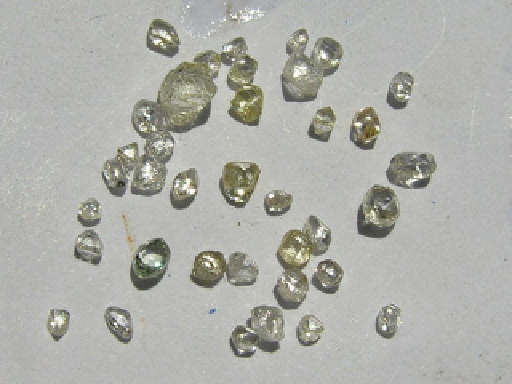Geology Reference
In-Depth Information
Table 16.4
Overburden thickness and gravel thickness measurements
on various Kwango targets
Primary
target area
(km
2
)
Gravel
thickness
(m)
Overburden
thickness
(m)
Strip ratio
(waste:
ore)
Target
K97
10.6
0.22
9.3
42
K82
5.5
0.32
10.8
34
Second splay
12.1
0.48
10.8
23
K64
6.6
0.18
11.6
64
Kitangu K56N
4.0
0.24
10.7
45
Bomba K56S
9.2
0.18
9.4
52
Flat 13/14
7.2
0.35
6.9
20
First Splay
4.5
0.6
4.1
7
Hilltop Pitting
0.14
3.6
26
Total
150
Fig. 16.20
Typical diamonds from the
'
international
'
Kwango below
the Falls with a high percentage colourless stones, many fragments and
a significant degree of abrasion
Table 16.5
Grade required to Break-Even (cpht) for Second Splay
target (strip ratio of 23:1)
Diamond value
$50/ct
Mining cost
(waste and ore)
16.5.5 Economic Modelling
$80/ct
$200/ct
$300/ct
$3/ton
141 cpht
88 cpht
35 cpht
24 cpht
$6/ton
282 cpht
176 cpht
71 cpht
47 cpht
In order to assess the economics of mining alluvial diamonds
along the Kwango, strip ratios, diamond values and grades
had to be evaluated against mining costs, which were
anticipated to be significantly higher than those for similar
sized placer operations in South Africa. This was due to lack
of infrastructure and the remoteness of the study area,
combined with legal and administrative complexities of
operating in the DRC.
Through its pitting and drilling program on the Kwango,
BRC was able to quantify with a reasonable level of confi-
dence the strip ratios (i.e. ratio of overburden to gravel
thickness) to be expected on various targets within its study
area. With the exception of First splay, which occurs at the
point where the Kwango River valley widens, strip ratios are
greater than 20 for the 8 targets on which sufficient over-
burden and gravel thickness data was collected (Table
16.4
).
Furthermore, the diamond size frequency distribution
analysis carried out by BRC within its Kwango project
area suggests stone sizes were generally small, with an
average stone size of 0.103 cts/stn (Table
16.2
). As a result,
it was estimated that diamond parcels from this area would
fetch low prices, in the range of US$50/ct to US$75/ct
(Maurice Barker, 2007, personal communication).
In order to establish diamond grades on the various
targets a trial mining campaign was contemplated by BRC,
utilizing a small mobile 5 tph DMS plant. Before proceeding
with this campaign, however, a break-even analysis was
carried out on the 9 targets for which strip ratios had been
sufficiently well established, in an attempt to determine the
spectrum of diamond grades required to recoup mining
costs, given a range of (i) Mining Costs ($/ton) and (ii)
$10/ton
470 cpht
294 cpht
118 cpht
78 cpht
Diamond Values ($/ct). Break-Even grade, expressed in
carats per hundred tonnes, is defined as the grade at which
revenues from mining operations pay for the costs of the
operations, thus generating no profits or losses. Break-even
grade was calculated using the following formula:
ðÞ
Diamond Value
Mining cost
$
=
t
Break
Even Grade cpht
ð
Þ ¼
‐
ð
$
=
ct
Þ
ð
Overburden Thickness
þ
Gravel Thickness
Þ
100
Gravel Thickness
Table
16.5
and Fig.
16.21
summarize results of the break-
even analysis for the Second Splay, with an overall strip
ratio of 23:1 (waste to ore).
These results suggest that diamond grades in excess of
150 cpht would be required to break-even on the Second
Splay given that:
1. Mining costs for a mechanized placer mining operation
on the Kwango in 2007 were anticipated to be in excess of
$4/ton.
2. Diamonds were estimated to be valued at $50 to $75/ct.
Had the analysis also taken into account Processing Costs
for
running a DMS plant
(
$6/ton) and General and
Administrative Costs (
$1/ton), the grades required to
break-even would have been even higher, likely in excess
of 400 cpht. The probability of attaining such grades, based
on historical and contemporary data was deemed to be low.





















Search WWH ::

Custom Search